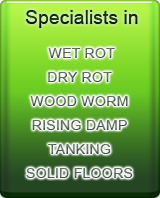Condensation
Condensation is very often misdiagnosed as penetrating damp or even rising damp.
Condensation forms on cold surfaces when moisture in the air comes into contact with them.

Moisture in the air is produced from every day living with activities such as cooking, drying clothes indoors, baths, showers and even just breathing. When the moisture laden air comes into contact with cold surfaces like doors, windows and walls it condenses into water droplets and is deposited on to the surface it touched.
Condensation problems are more typical in the winter months where external temperatures are lower than internal temperatures making external walls, single glazed windows, or old or damaged double glazing and bridged elements in cavity walls such as lintels and doors to be the main target for condensation.
Kitchens and bathrooms are the main rooms in a home that suffer from condensation all year round due to the very high atmospheric moisture levels.
A certain amount of condensation is normal on single glazed windows or in bathrooms after bathing and kitchens after cooking. The problem occurs when moulds start to develop or excessive water is running into fabrics, decoration or the woodwork causing deterioration and decay.
Combating condensation
Its a balancing act between the heating and ventilation to control condensation.
Keep areas with condensation well ventilated to help get rid of the moist air before it condenses on cold surfaces. An extraction fan can help expel moisture in areas of particular condensation build up like the bathroom or kitchen.
Don’t be tempted to over heat the room as hot air holds moisture better cooler air. It is better to try and warm up the interior surfaces that have the condensing problem instead of just raising the overall temperature so the positioning of radiators and other heat sources is important.
Use insulation in walls and improve double glazing to keep the number of internal cold surfaces down to a minimum.
A dehumidifier can help in certain cases where moisture is a persistent problem like in a commercial kitchen or laundry shop for example.
Get a professional inspection
To get the correct diagnosis and to get expert advice












